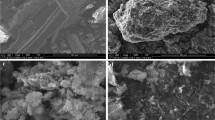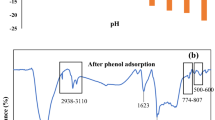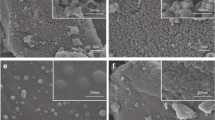Abstract
The overall objective of this research was to evaluate the performance of tailored activated carbons in the adsorption of bisphenol A (BPA). The results indicated that the experimental data were well described with pseudo second-order kinetic model. Activated carbon samples (F600-A and OLC-A) tailored with acidic treatment processed better adsorption rates, and the adsorption rates D reached 46.512 and 46.083 mg/g h, respectively. In addition, the roles of water parameters were also investigated. BPA adsorption rate was reduced with increasing pH because of an increase in electrostatic repulsion and a decrease in hydrogen bond interactions. It was found that the adsorbed amount of BPA increased with the increase of temperature from 288 to 318 K. Finally, ionic strength was found to play an important role in promoting BPA adsorption rate by increasing π–π dispersion interaction.






Similar content being viewed by others
References
Belfroid, A., van Velzen, M., van der Horst, B., & Vethaak, D. (2002). Occurrence of bisphenol A in surface water and uptake in fish: evaluation of field measurements. Chemosphere, 49, 97–103.
Chang, H.-S., Choo, K.-H., Lee, B., & Choi, S.-J. (2009). The methods of identification, analysis, and removal of endocrine disrupting compounds (EDCs) in water. Journal of Hazardous Materials, 172, 1–12.
Chen, W., Duan, L., & Zhu, D. (2007). Adsorption of polar and nonpolar organic chemicals to carbon nanotubes. Environmental Science & Technology, 41, 8295–8300.
Choi, K. J., Kim, S. G., Kim, C. W., & Kim, S. H. (2005). Effects of activated carbon types and service life on removal of endocrine disrupting chemicals: amitrol, nonylphenol, and bisphenol-A. Chemosphere, 58, 1535–1545.
Crittenden, J. C., Sanongraj, S., Bulloch, J. L., Hand, D. W., Rogers, T. N., Speth, T. F., & Ulmer, M. (1999). Correlation of aqueous-phase adsorption isotherms. Environmental Science & Technology, 33, 2926–2933.
Díaz-Cruz, M. S., & Barceló, D. (2008). Trace organic chemicals contamination in ground water recharge. Chemosphere, 72, 333–342.
Fick, J., Söderström, H., Lindberg, R. H., Phan, C., Tysklind, M., & Larsson, D. G. J. (2009). Contamination of surface, ground, and drinking water from pharmaceutical production. Environmental Toxicology and Chemistry, 28, 2522–2527.
Gómez, M. J., Martínez Bueno, M. J., Lacorte, S., Fernández-Alba, A. R., & Agüera, A. (2007). Pilot survey monitoring pharmaceuticals and related compounds in a sewage treatment plant located on the Mediterranean coast. Chemosphere, 66, 993–1002.
Guibal, E., McCarrick, P., & Tobin, J. M. (2003). Comparison of the sorption of anionic dyes on activated carbon and chitosan derivatives from dilute solutions. Separation Science and Technology, 38, 3049–3073.
Kalra, A., Tugcu, N., Cramer, S. M., & Garde, S. (2001). Salting-in and salting-out of hydrophobic solutes in aqueous salt solutions. The Journal of Physical Chemistry B, 105, 6380–6386.
Kang, J.-H., Kondo, F., & Katayama, Y. (2006). Human exposure to bisphenol A. Toxicology, 226, 79–89.
Özcan, A., & Özcan, A. S. (2005). Adsorption of Acid Red 57 from aqueous solutions onto surfactant-modified sepiolite. Journal of Hazardous Materials, 125, 252–259.
Staples, C. A., Dorn, P. B., Klecka, G. M., O’Block, S. T., Branson, D. R., & Harris, L. R. (2000). Bisphenol A concentrations in receiving waters near US manufacturing and processing facilities. Chemosphere, 40, 521–525.
Tsai, W.-T., Lai, C.-W., & Su, T.-Y. (2006). Adsorption of bisphenol-A from aqueous solution onto minerals and carbon adsorbents. Journal of Hazardous Materials, 134, 169–175.
Vieno, N. M., Tuhkanen, T., & Kronberg, L. (2005). Seasonal variation in the occurrence of pharmaceuticals in effluents from a sewage treatment plant and in the recipient water. Environmental Science & Technology, 39, 8220–8226.
Yang, K., & Xing, B. (2009). Adsorption of fulvic acid by carbon nanotubes from water. Environmental Pollution, 157, 1095–1100.
Acknowledgments
The authors would like to thank the financial support from the Science and Technology Department of Zhejiang province (Project 2014C03002) and Powerchina Huadong Engineering Corporation (Project BH150093YF).
Author information
Authors and Affiliations
Corresponding author
Electronic supplementary material
Below is the link to the electronic supplementary material.
ESM 1
(DOC 1239 kb)
Rights and permissions
About this article
Cite this article
Huang, X., Lv, D., Yan, L. et al. Effects of Water Factors on the Effectiveness of EDC Adsorption on Novel Tailored Activated Carbon. Water Air Soil Pollut 227, 398 (2016). https://doi.org/10.1007/s11270-016-3104-8
Received:
Accepted:
Published:
DOI: https://doi.org/10.1007/s11270-016-3104-8




